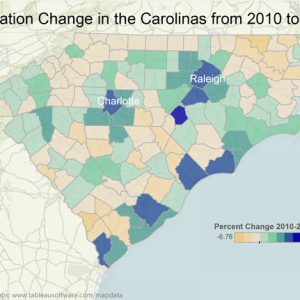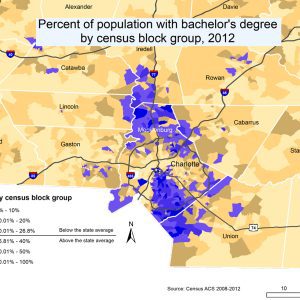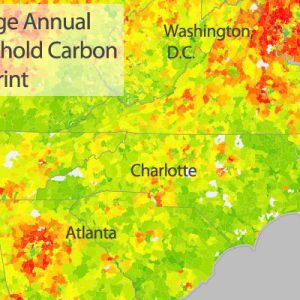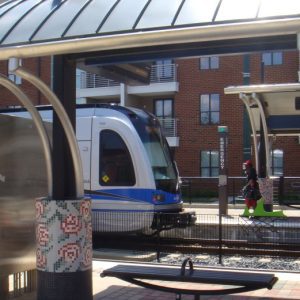Urban Growth

Has Charlotte metro income really declined?
Recently the site FiveThirtyEight.com reported that of the largest U.S. metros, only Charlotte’s median income, “experienced a statistically significant decline” in 2013. What’s going on? That statement may signal to the casual reader that wages are sinking in the Charlotte region. In reality, however, that “statistically significant decline” appears to be the result of a […]

Region’s preferred way to grow: Save rural areas, strengthen towns
Charlotte area residents have a vision for their region’s growth. By 2050, they want to see more farms and rural areas preserved, less suburban development and more development that blends housing, stores and offices. Those are the key takeaways from nearly two years of public meetings, surveys, and work sessions, all part of the “CONNECT […]

Charlotte and Raleigh top U.N. list of fastest growing large U.S. cities
City population projections produced by the United Nations show Charlotte and Raleigh as growing the fastest among large U.S. cities from 2010 to 2030. The United Nations produces population estimates and projections for cities from Shanghai to Johannesburg – including cities in the U.S. The U.N. uses areas it calls “urban agglomerations,*” which measure the […]

Voters born elsewhere make up nearly half of N.C. electorate
One hundred years ago, when North Carolina had a population of about 2.5 million people, more than nine out of 10 residents were native Tar Heels. Today’s North Carolina, in contrast, approaches a population of 10 million, with more than 4 million residents born in another state or country. Population growth and change have had […]

Charlotte hits pivot point in vision for Eastland property
The old photo shocked me. I was researching Charlotte’s urban renewal, and amid faded images of long-demolished homes in and around uptown was a large old house on Dilworth’s now-affluent East Kingston Avenue. But in the 1960s parts of Dilworth were considered blighted. Dilworth was not demolished for urban “renewal.” Instead, young Baby Boomers moved […]

Suburbia? It’s all about status, says author Ben Ross
When you hear that a new book “opens my eyes to an entirely new way of thinking,” as “Better! Cities & Towns” editor Rob Steuteville wrote, you may want to pay attention. Dead End: Suburban Sprawl and the Rebirth of American Urbanism, by Benjamin Ross (Oxford University Press, 2014) has the potential to change the […]

Big urban gains, rural losses in the Carolinas
North Carolina continues to grow faster than the U.S. average and faster than all but two other Southeastern states.* That growth is increasingly uneven and concentrated in the metro areas of Charlotte and Raleigh. The Carolinas have a long history of being a small-town and small-city region of the country. The latest census population estimates […]

Smart metros: Charlotte and North Carolina
Charlotte’s metro has one of the fastest-growing college-educated populations in the U.S. Where exactly do the educated live in Charlotte? As people with college degrees cluster in metros, what does that mean for rural areas? The number of college-educated adults exceeds 40 percent of the working population in just a handfull of counties across the […]

How green is your ZIP code? Charlotte’s carbon footprint
The carbon footprint of a household can vary greatly based on income and location. Researchers from UC Berkeley included these factors in a new analysis. The result is a set of interactive maps that show carbon footprints based on ZIP codes.** Household greenhouse gas emissions are lower in central cities compared to suburbs, but the […]

Affordable housing near Charlotte light rail? Still a challenge
As hundreds of apartments pop up around transit stations in Charlotte’s South End neighborhood near uptown, the city’s plan for more high-density housing near its young rail line is beginning to take shape. But a sister policy encouraging apartments for low-income families isn’t faring as well. In the six years since the Lynx Blue Line […]